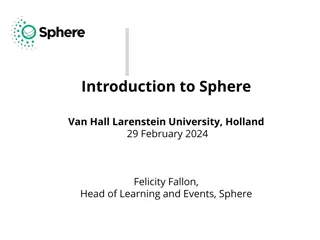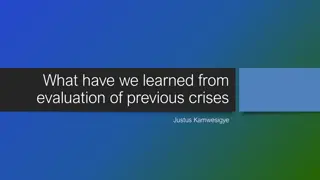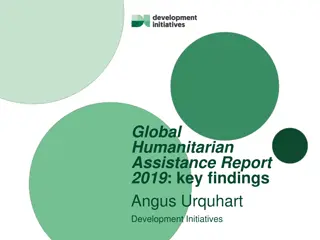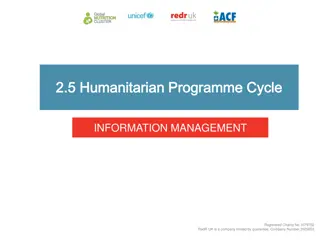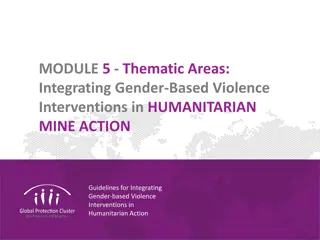Humanitarian Action and Coordination: Essential Guidelines and Standards
This comprehensive guide provides insights on coordinating child and adolescent health in humanitarian settings, emphasizing the importance of understanding and implementing key actions. It covers the utilization of resources like the operational guide, self-assessment tracker, and core humanitarian standards to enhance the quality and impact of humanitarian work, guided by principles such as humanity, impartiality, and neutrality. The focus is on operational efficiency, continuous improvement, and adherence to international laws and rights.
Download Presentation

Please find below an Image/Link to download the presentation.
The content on the website is provided AS IS for your information and personal use only. It may not be sold, licensed, or shared on other websites without obtaining consent from the author. Download presentation by click this link. If you encounter any issues during the download, it is possible that the publisher has removed the file from their server.
E N D
Presentation Transcript
Child and adolescent health in humanitarian settings: operational guide 2
How to use the guide A. Get familiar with the entire guide B. Identify areas most useful for your team (usually coordinate) C. Review key actions and step by step approach to address the key actions (to the best of your ability) D. Repeat the cycle, each time addressing things more fully Work through the entire guide in preparation for an emergency Quickly work through the guide in the first month of an emergency, then systematically revisit all the sections over the next 3-6 months. Systematically review all of the guide every 6 months during a protracted emergency and into the recovery period. Use the Self-Assessment Progress Tracker (Annex 1) to track your improvement. 3
Implementing the guide Dr Tedros on an organizational shift WHO is known for the quality of its normative work, but there is little value in publishing a guideline if nobody uses it. We need a much greater emphasis on making sure our world-class technical work is used at country level, and a much greater focus on measuring the impact of that work. 4
Humanitarian Principles Humanitarian action is guided by humanitarian principles: humanity, impartiality, neutrality, independence These are grounded in human rights and international law: The right to live with dignity The right to receive humanitarian assistance The right to protection and security Children have additional rights Convention of the Rights of the Child 5
Core Humanitarian Standard Consensus document setting the 9 principles to help humanitarian actors improve the quality and effectiveness of humanitarian action 6
The Sphere Handbook Main humanitarian guidance documents Created by a broad group of humanitarian actors, accepted by most humanitarian agencies Includes the Humanitarian Charter outlines ethical and legal foundations of humanitarian action, and the Minimum Standards in the Humanitarian Response Standards have been adopted by UN and other agencies Main sources for key actions and indicators in the operational guide Link 7
Effective Coordination in Humanitarian Emergencies Humanitarian coordination involves bringing together humanitarian actors to ensure a coherent and principled response to emergencies. The aim is to assist people when they most need relief and protection. Humanitarian coordination seeks to improve the effectiveness of humanitarian response by ensuring greater predictability, accountability, and partnership. Effective coordination is essential, yet challenging Variations in approaches and perceived priorities among humanitarian actors Importance of system-wide coordination for quick and efficient assistance The coordination section guides you in setting up and participating effectively in coordination structures during humanitarian emergencies 8
The four interconnected programmatic action areas of the operational guide ASSESS & PRIORITISE How to obtain data on child/adolescent health (via needs assessment) and use it to prioritize actions COORDINATE How to take a coordinated approach to child and adolescent health in a humanitarian emergency RESPOND How to plan and enact a coordinated set of activities addressing the identified child and adolescent health priorities MONITOR, EVALUATE & REVIEW How to use data systems to review and improve child and adolescent health- related activities 9
Coordinate how to take a coordinated approach to child and adolescent health in a humanitarian emergency 11
Participate in humanitarian structures To integrate child and adolescent health into humanitarian action effectively, governments and organizations must be able to navigate humanitarian structures Global level Inter-Agency Standing Committee (IASC) Coordinates humanitarian action and is headed by the Emergency Relief Coordinator Composed of UN agencies and international NGOs Responsible for coordinating key agencies assigning responsibilities and sharing resources and information Designates responsibility using a cluster approach 13
Cluster approach A cluster approach may be used in humanitarian emergencies The cluster approach is activated by the Emergency Relief Coordinator (ERC) at the request of the Humanitarian Coordinator, with the endorsement of the inter-agency standing committee (IASC) principals All clusters have lead organisations, Cluster Lead Agencies, operating at the global and country levels The cluster system spreads accountability for the delivery of services (health, shelter, etc) across different cluster lead agencies Clusters are groups of humanitarian UN and non-UN organizations in each of the main sectors of humanitarian action (water, health, shelter, logistics etc) They are designated by IASC and have clear responsibilities for coordination Aim: to build capacity of national systems to respond to humanitarian situations with a protection and accountability lens and progressively hand over coordination to local entities 14
Clusters and global lead agencies for humanitarian action 15
Participate in humanitarian structures To integrate child and adolescent health into humanitarian action effectively, governments and organizations must be able to navigate humanitarian structures National level Clusters are only activated by IASC when existing structures are unable or unwilling to meet the needs of a particular humanitarian emergency In-country clusters are intended to be a temporary coordination solution with handover to local authorities as soon as feasible United Nations Office for the Coordination of Humanitarian Affairs (UN OCHA) or national government usually oversees all clusters 16
Participate in humanitarian structures Humanitarian emergencies attract a wide range of actors Governance structures may not always be clear, especially in the early stages of an emergency Clusters should go beyond information sharing and make coordinated decisions about resources, activities, and strategic direction A RMNCAH/child and adolescent health working group can fulfil the role of health cluster, preferably led by the ministry of health 17
Key actions humanitarian structures Identify and communicate - Contact the leading health cluster organization (national or subnational) to coordinate activities - Share your work areas and offer coordination support Support coordination - Assist in establishing a coordination mechanism if existing ones are lacking or weak Conduct coordination meetings - Conduct regular coordination meetings at different levels involving health-related organizations Share information - Regularly share updates and bulletins, involving all health-related organizations 18
Key indicator humanitarian structures Your organization is connected with the health sector/cluster in your region, actively communicates with partners and contributes to health (and other) sector/cluster updates 19
Identify key humanitarian actors Government: ministries of health, other ministries, district health directors Most important actors: affected communities and individuals Local community: health facilities, schools, civil society groups Local NGOs UN: International NGOs: CARE International, Caritas, ICRC, IFRC, MSF, IRC, Save the Children, World Vision, Oxfam, Islamic Relief, and more UNOCHA, WHO, UNICEF, UNDP, UNFPA, UNHCR, WFP, UNRWA, OHCHR, FAO, UN-Habitat, Department of Peace Operations Interagency: IASC, IAWG, International Military, SCHR 21
Roles and responsibilities of major actors in the humanitarian field UN Agencies: Coordination and technical expertise Governments: Main responsibility for population protection, coordination, implementation, funding, local expertise Local Community and NGOs: Main providers of humanitarian action, staff, local expertise International NGOs: Implementation, coordination in specific areas, staff, technical expertise, advocacy and resource mobilisation 22
Accountability to Affected Populations Taking Account: Enabling input from affected populations Giving Account: Providing information on actions and reasons Being Held to Account: Allowing communities to assess the quality of the response 23
Inter-Agency Standing Committee (IASC) Commitments on Accountability to Affected Populations Leadership/Governance Transparency Feedback and Complaints - Actively seek views of affected populations to improve policy and practice. - Streamline robust feedback and complaint mechanisms. Participation Design, Monitoring, and Evaluation - Engage affected populations in designing, monitoring, and evaluating program goals. - Report and learn from the process to improve outcomes. - Integrate feedback and accountability mechanisms into all aspects: strategies, proposals, monitoring, evaluations, recruitment, and reporting. - Provide accessible and timely information to affected populations. - Facilitate dialogue for informed decisions. - Enable active involvement of affected populations in decision- making processes. - Establish clear guidelines for engagement and representation of marginalized groups. 24
Key actions humanitarian actors Identify and engage partners - Identify and reach out to partners within child and adolescent health - Work collaboratively to establish common systems and prevent duplication Integrate Core Humanitarian Standards - Integrate the Core Humanitarian Standards into your operations - Utilize these standards to hold yourselves (and others) accountable for humanitarian engagement 25
Key indicator humanitarian actors Health sector leads have identified and connected with the health sector lead agency and partners in child and adolescent health, and are committed to working together. 26
Establish or strengthen an RMNCAH/CAH working group Importance of interagency RMNCAH/CAH working group: essential for effective and cooperative integration of RMNCAH/CAH activities into humanitarian action Should operate under the health cluster WHO and MoH are accountable for RMNCAH/CAH activities and should nominate a leading agency(ies) for the working group Can be led by government bodies, local or international NGOs, or UN agencies collaborating effectively with MoH Include members from various sectors/clusters (nutrition, protection, WASH, education) due to cross- cutting issues related to child and adolescent health Important to coordinate activities locally and provide feedback, linked to both local health authorities and the national RMNCAH/CAH working group 28
Key actions working group Identify lead agency(ies) to lead the RMNCAH/CAH working group Establish working group at your level - Determine composition, including civil society members and young people - Develop ToRs and roles - Develop a plan for working group meetings, communication, and coordination with other humanitarian responders Liaise with stakeholders - Clarify roles and integrate RMNCAH/CAH priorities into the humanitarian response plan Engage partners and contribute updates - Meet regularly and contribute to health and other cluster/sector updates 29
Key indicators working group At the onset of an emergency response, a national RMNCAH/CAH working group has been established (under the health cluster) with a nominated group lead and clear terms of reference. Subnational RMNCAH/CAH working groups have been established where needed. The RMNCAH/CAH working groups meet regularly and communicate their activities with other agencies, clusters/sectors and the community RMNCAH/CAH issues are fully included in humanitarian response plans 30
Communicate clearly Effective communication strategies require an understanding of the situation, affected people, current response efforts, and available communication channels It is important to address the needs and capacities of children in communication strategies Useful Tool: UNICEF's Communication for Humanitarian Action Toolkit (CHAT) provides useful tools 32
Communication for humanitarian action toolkit (CHAT) principles 1. Be prepared and communicate now 2. Work with partners and coordinate communication activities 3. Engage with communities 4. Build an evidence base through formative research 5. Promote awareness and action 6. Wherever possible, test your approach 7. Assess your impact 33
Key actions communication Communicate - Communicate urgent messages to the affected population now do not delay Develop a communication strategy - Assess the current situation to identify priorities, target populations and existing communications - Involve children and young people Coordinate Coordinate CAH-related health messages between agencies and sectors 34
Key indicators communication The RMNCAH/CAH working group, and individual organizations, have developed a communication strategy and are working together to implement it 35
Advocate strongly Advocate to decision-makers about the benefits of effective coordination Target audience: government, NGOs, UN agencies, community leaders, donors, and health managers at all levels (local, national, global) Be an effective change agent Advocate for the health needs of children and adolescents to decision-makers Engage children, adolescents, and parents 37
Nurturing care for children living in humanitarian settings Humanitarian standards vary in their intention to children and their caregivers In 2021 a thematic brief was launched to shed light on the need to better ensure children in humanitarian settings receive nurturing care The brief summarizes what programme planners and implementers can do to minimize the impact that emergencies have on the lives of young children and their families
Key actions advocacy Take the lead - RMNCAH/CAH working group takes the lead in advocating for CAH in humanitarian settings Work together - Health leaders / agencies in CAH work together to advocate for the needs of children and adolescents, including: human rights, data, prioritization, funding, community, participation 39
Key indicators advocacy The RMNCAH/CAH working group, and individual organizations, work together to advocate for the health needs of children and adolescents 40
Resources Coordinate Core Humanitarian Standard on Quality and Accountability. Geneva: HAP International, People in Aid and the Sphere Project; 2014 (https://corehumanitarianstandard.org/language-versions) Health cluster guide: a practical handbook. Geneva: World Health Organization; 2020. Licence: CC BY-NC-SA 3.0 IGO (https://fctc.who.int/publications/i/item/9789240004726) IASC Operational guidance for cluster lead agencies on working with national authorities. Geneva: Inter-Agency Standing Committee; 2011 (https://reliefweb.int/report/world/operational-guidance-cluster-lead-agencies-working- national-authorities-july-2011) Reference module for cluster coordination at country level. Geneva: Inter-Agency Standing Committee; 2015 (https://interagencystandingcommittee.org/iasc-transformative-agenda/iasc-reference-module-cluster-coordination- country-level-revised-july-2015. 41
Tools Coordinate 1. Humanitarian ID: Personalized ID for humanitarian workers, granting access to contact lists and platforms like Humanitarian Response and ReliefWeb. 2. Humanitarian Response: Central website for humanitarian tools and services, enabling information exchange among operational responders during emergencies. Provided by UN OCHA. 3. ReliefWeb: Leading source for global crises and disasters information, offering reports, maps, infographics, and videos. Provided by UN OCHA. 4. Humanitarian Data Exchange (HDX): Open platform for sharing humanitarian data, aiming to make it easily accessible for analysis. Provided by UN OCHA. 5. NGO Coordination Resource Centre: One-stop-shop for nongovernmental organizations during humanitarian emergencies. Provided by the International Council of Voluntary Agencies. 6. Accountability to Affected Populations: Tools to assist in implementing the IASC AAP commitments. 7. Operational Guidance on Accountability to Affected Populations (AAP): Health Cluster's guidance from August 2017. 8. Communicating Risk in Public Health Emergencies: WHO guideline for emergency risk communication (ERC) policy and practice. 9. Communication for Humanitarian Action Toolkit (CHAT): Toolkit by United Nations Children s Fund containing strategy tool, survey tool, and additional useful information. 10. Behaviour Change Communication in Emergencies: Toolkit by UNICEF for behavior change communication during emergencies. 11. Using Social Media for Crisis Engagement: Guide by ICRC, IFRC, and UN OCHA on utilizing social media for engaging affected populations. 42
Thank you For more information, please contact: Khalid Siddeeg, Regional Advisor EMRO, siddeegk@who.int Kim Beentjes, Technical Officer EMRO, beentjesk@who.int





